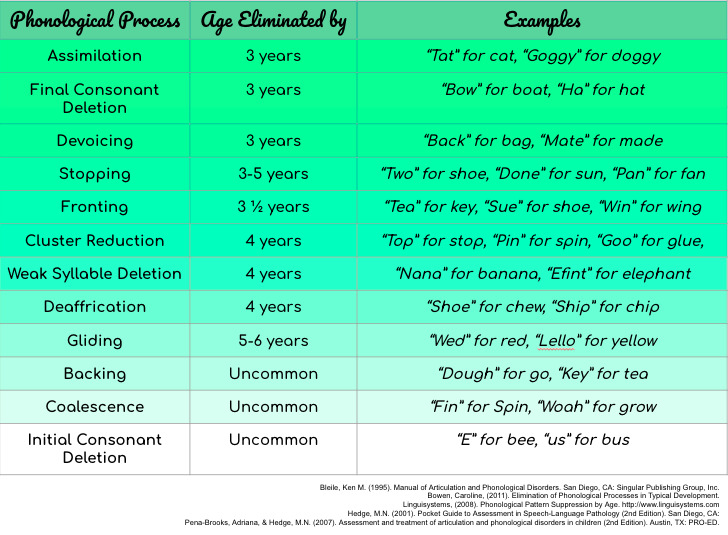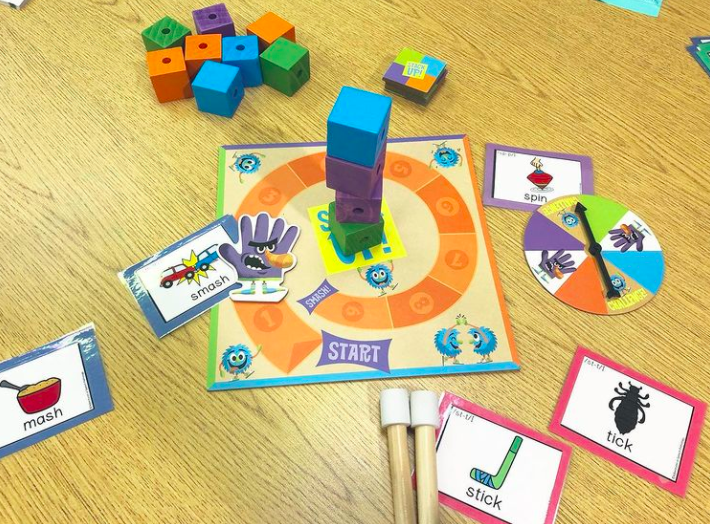When your little one first starts to talk, your first reaction may be to film everything they say because, well, it is just so adorable when they say “ ay da tick” when they were really trying to tell you “The doggy ate the stick.” Those videos will be fondly watched for ages and used at birthday parties, family get togethers, and celebrations for years to come, however, depending on your child’s age, they may benefit from working with a speech therapist to become more easily understood.
Types of Speech Sound Disorders
Typically, speech sound disorders are thought of as a child having difficulty producing R or saying S (see our blog post on articulation disorders!). However, speech sound disorders is an umbrella term that can refer to many different types of speech deficits that children can have. Three of the main categories of speech sound disorders are Childhood Apraxia of Speech (CAS), Phonological Processes and Articulation Errors.
Typically, speech sound disorders are characterized by a deletion of a sound from a word, addition of a sound to a word, substitution of one sound for another, or distortion of a speech sound.
(Of note, speech sound disorders can include a multitude of other characteristics, not just the brief description given above.)
What is a Phonological Process?
Phonological processes are patterns of sound errors that initially serve to simplify speech as our little ones are learning to talk. Phonological processes are most commonly characterized by:
- Sound Substitutions: Switching one sound for another
- Example: substituting “T” for ‘K’ like “tea” for ‘key’
- Sound Deletions: Not saying all of the sounds in a word
- Example: saying “top” for ‘stop’ or saying “ca” for ‘cat’
- Sound Additions: Adding a sound to a word
- Example: saying “stun” for ‘sun’
While these patterns of change to or simplification of words in our child’s speech are expected and considered developmental as one grows and learns language, they can sometimes persist past the age we typically expect them to. Below you’ll find a chart with a list of the most common phonological processes, the typical age we can expect little ones to “eliminate” them, and an example of each:

How do I fix my child’s speech?
After speaking and meeting with a speech language pathologist, they may recommend therapy to work on your child’s speech skills and phonological processes. There are a variety of approaches that an SLP may choose to take with your child and there is no “best” approach for every child.
When deciding on a therapy approach, a speech therapist considers many variables. First, an SLP considers how many phonological processes your child may have and the types of phonological processes your child may have. They also may consider your child’s confidence level with their speech, attention span to certain tasks, and level of importance to lead to the most improvement. Additionally, an SLP may change approaches during intervention to best meet the needs of your child.
Phonological Approaches:
- Minimal Pairs: This approach works to compare your child’s wrong production with what they meant to say. It serves to show your child that what he or she is saying did not make sense to us. For example, we may show a child a picture of “pin” and point to that with a confused look on our face, when they tried to ask if they could spin for the their turn on the game.
- Cycles: This approach is typically used with children who present with many phonological processes. It follows a specific schedule in which your child works on a specific phonological process for 1 hour of therapy and then moves onto another phonological process. Once all processes have been addressed with an hour of treatment, the therapist cycles back to the beginning. There are many benefits for using the cycles approach with kids who are really hard to understand.
- Multiple Oppositions: This approach is primarily used for children who have a phoneme collapse**.** A **phoneme collapse** is when a child uses one sound in place of many (Example: they may use H for many sounds and say “Hi” for ‘bye, pie, guy, my, tie, shy, lie). Multiple Oppositions is similar to the minimal pairs approach above, but instead of comparing two words (example: pin/spin) , it compares multiple words at once (example: hi, pie, tie, my).
- Maximal Oppositions: This approach is when a child will practice pairs of words, similar to minimal pairs above, however the sounds within the pairs will be carefully chosen by a speech therapist so that they are maximally different.

In this picture, you’ll see the set up for a session working on cluster reduction within a fun, engaging game.
It is important to note that this is a brief overview of the treatment speech therapists use for phonological processes and many others exist that are not mentioned in this post.
What can I do to help my child’s speech?
After working with a speech therapist to determine what sounds and patterns your child has difficulty with, they will form a treatment plan individualized for your child. In therapy sessions, your therapist will work on improving your child’s speech while playing games to keep their attention and engagement. Spending 30-60 minutes a week in therapy, however, is typically not enough to perfect a child’s speech. The real magic, as we call it at MollyBSLP, is the practice you do at home.
Research shows that getting short bursts of accurate practice multiple times each day leads to great generalization and growth. Once your child is able to produce words accurately and independently, your speech therapist may give you speech homework with words to practice at home. You can tape these words somewhere familiar that your child will see multiple times a day (the fridge, the car, the TV); each time your child sees his or her words, have them practice it by reading down the list of words twice… then move on with your day. Before you know it, your child has completed his speech homework without having to actively sit down and remember to do it.
How do I find a speech therapist near me?
Do you live in New Jersey, New York, or Virginia? Then look no further, we at MollyBSLP specialize in working with speech sound disorders, like the phonological processes described above. We offer virtual therapy for families in NY, and VA.
Do you have concerns about your child’s speech development?
References
- Bleile, Ken M. (1995). Manual of Articulation and Phonological Disorders. San Diego, CA: Singular Publishing Group, Inc.
- Bowen, Caroline, (2011). Elimination of Phonological Processes in Typical Development.
- Hedge, M.N. (2001). Pocket Guide to Assessment in Speech-Language Pathology (2nd Edition). San Diego, CA:
- Linguisystems, (2008). Phonological Pattern Suppression by Age.
- Pena-Brooks, Adriana, & Hedge, M.N. (2007). Assessment and treatment of articulation and phonological disorders in children (2nd Edition). Austin, TX: PRO-ED.